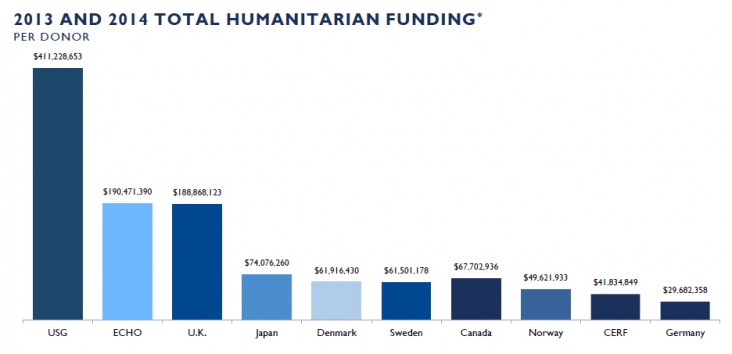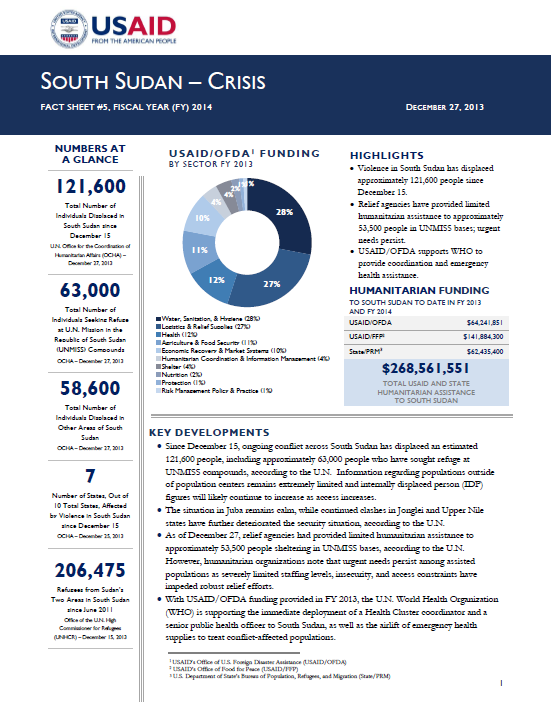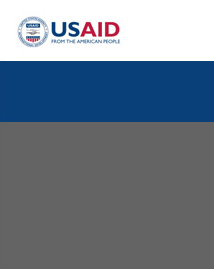- What We Do
- Agriculture and Food Security
- Democracy, Human Rights and Governance
- Economic Growth and Trade
- Education
- Environment and Global Climate Change
- Gender Equality and Women's Empowerment
- Global Health
- Humanitarian Assistance
- Transformation at USAID
- Water and Sanitation
- Working in Crises and Conflict
- U.S. Global Development Lab
Speeches Shim
March 7, 2014
Numbers At A Glance
705,800
77,400
628,400
226,000
234,300
Humanitarian Funding:
To South Sudan To Date In FY2013 and FY2014:
| USAID/OFDA | $87,174,812 |
| USAID/FFP | $141,884,300 |
| State/PRMDoD | $94,735,400 |
| TOTAL | $323,794,512 |
Highlights
Volatile security conditions persist in Jonglei, Unity, and Upper Nile states.
Food insecurity and malnutrition concerns escalate as conflict impedes aid operations and disrupts market activities.
Relief agencies press armed actors for unfettered humanitarian access to all conflict-affected and displaced people.
KEY DEVELOPMENTS
Vulnerable populations continue to flee ongoing fighting in South Sudan, with violence displacing more than 930,000 people—including both internally displaced persons (IDPs) and refugees fleeing to neighboring countries—since December 15, according to the U.N.
During February, violence against relief workers, movement restrictions, and ongoing hostilities continued to hinder humanitarian relief activities in South Sudan. The U.N. reports that conflict increased in remote, rural areas, where humanitarian presence is limited, while the Government of the Republic of South Sudan (RSS) forces and opposition groups were both responsible for access denials, harassment and extortion of aid workers, and other constraints, particularly in Central Equatoria, Jonglei, and Unity states. In addition to persistent insecurity, the RSS continues to restrict humanitarian access to opposition-controlled areas. With USAID/OFDA support, OCHA is coordinating security clearances on behalf of relief agencies and advocating for unfettered humanitarian access to all conflict-affected populations in South Sudan.
To date in 2014, relief agencies have provided emergency food assistance to approximately 440,000 of the estimated 4.9 million people in need of humanitarian aid, according to the U.N. Assisted populations have also received limited health, protection, shelter, and water, sanitation, and hygiene (WASH) support, while an additional 320,000 people—including Sudanese refugees located in South Sudan and IDPs in Abyei Area—have received food assistance from USAID/FFP partner the U.N. World Food Program (WFP).
SITUATION, DISPLACEMENT, AND HUMANITARIAN NEEDS UPDATE
Active hostilities continue to affect populations in Jonglei, Unity, and Upper Nile. Fighting in Upper Nile, particularly in Malakal and Melut counties, is triggering fear and additional displacement of vulnerable populations, according to the U.N. Tensions are mounting in Dethoma and Melut towns, where large populations of IDPs have sought shelter in recent weeks. As of March 6, violence had displaced more than 116,000 people in Upper Nile, while approximately 186,000 IDPs are located in Unity, and nearly 143,000 individuals are displaced in Jonglei.
On March 5, heavy fighting erupted in South Sudan’s capital of Juba town, Central Equatoria State, reportedly among Sudan People’s Liberation Army (SPLA) elements. Although the situation has since stabilized, tensions remain high.
Increasing levels of food insecurity due to ongoing fighting and resultant restrictions on food access are affecting nutrition conditions for conflict-affected and vulnerable populations in South Sudan. According to the U.N. Children’s Fund (UNICEF), admission in treatment centers for severe acute malnutrition increased from nearly 5,200 cases to more than 8,400 cases in the past two weeks. Although the increase is largely attributed to the expansion of nutrition services at UNMISS bases in Central Equatoria, Jonglei, Unity, and Upper Nile, relief agencies remain concerned by populations that are at increased risk of malnutrition due to poor access to reliable food sources.
Although relief agencies are currently providing adequate safe drinking water for IDP populations sheltering at the UNMISS base in Melut and across Awerial County, Lakes State, overall WASH conditions remain a serious concern. Because of large IDP populations and an inadequate presence of relief workers due to insecurity-prompted evacuations, the WASH conditions at most displacement sites in South Sudan—including at the Malakal UNMISS site and in Nimule town, Eastern Equatoria—remain below global emergency WASH standards, according to the U.N.
At the UNMISS bases in Bentiu town, Unity State, and Malakal, overcrowding and fluid population demographics are key challenges, according to humanitarian organizations. Overcrowding in Malakal is a major challenge, creating fire hazards, health concerns, and inadequate space for relief services, including the construction of latrines and additional water supply points. Meanwhile, at the Bentiu UNMISS base, new influxes of IDPs have led to registration challenges and problems with providing an adequate supply of safe drinking water.
While the humanitarian response continues for refugees in Unity and Upper Nile, ongoing insecurity has constrained road and river access to refugee camps in Maban County, Upper Nile, limiting the accessibility of food sources and hindering pre-positioning efforts. Tensions over scarce resources have triggered conflict between refugees and host populations in Maban, according to the U.N.
South Sudan Crisis Fact Sheet #32 March 7, 2014 ![]() (pdf - 298k)
(pdf - 298k)
South Sudan Crisis Map March 7, 2014 ![]() (pdf - 973k)
(pdf - 973k)
HUMANITARIAN ACCESS CONSTRAINTS
Violence against relief workers, access constraints, and harassment at checkpoints continue to hinder humanitarian access to conflict-affected populations throughout South Sudan. In February, the U.N. recorded 29 incidents of violence against relief workers—a 42 percent decrease from reported incidents in January. However, the U.N. notes that the decrease is likely due to delays in incident reporting, as conflict-related violence has shifted from population centers to rural areas. Access restrictions imposed by state actors account for nearly two-thirds of overall incidents in February, marking an increase from January, according to the U.N. In addition, humanitarian actors continue to report high levels of harassment by the SPLA at checkpoints in Jonglei and along the road from Juba to Bor town, Jonglei, and other major roads, where armed actors force convoys to pay illegal taxes and deny passage. In Unity, harassment by security forces escalated into violent ambushes of several humanitarian convoys, ultimately resulting in the death of three contractors in Rubkona town on February 16.
On February 19, RSS authorities responded to pressure from the humanitarian community in Juba by issuing a letter to all state police commissioners in South Sudan ordering an immediate cessation of harassment and taxation of humanitarian convoys at security checkpoints. However, WFP reports that armed actors still collect fees at checkpoints and drivers remain fearful of targeting by armed actors.
Despite security and access constraints and limited cooperation from armed forces, the U.N., relief agencies, and international donors continue to advocate for additional access. USAID/OFDA partner OCHA continues to coordinate flight security clearances on behalf of relief agencies and advocate for additional cooperation regarding humanitarian air travel. OCHA also obtained approval from senior opposition commanders in Jonglei, Unity, and Upper Nile on fundamental humanitarian access documents, facilitating access to opposition-held areas.
HUMANITARIAN RESPONSE ACTIVITIES
Despite severe access constraints, relief agencies have provided emergency assistance—including food rations, health care services, protection, shelter, and WASH support—to approximately 440,000 people at nearly 60 displacement sites in South Sudan, according to the U.N. An additional 320,000 people—including Sudanese refugees located in South Sudan and IDPs in Abyei Area—have received routine food assistance from USAID/FFP partner WFP, while humanitarian activities continue to support communities in areas not directly affected by the current hostilities, including Lakes, Northern Bahr el Ghazal, Western Bahr el Ghazal, and Western Equatoria states.
Relief agencies continue to respond to persistent civilian protection concerns, providing protection activities—such as psychosocial support, family reunification, and gender-based violence prevention and response—for nearly 317,000 individuals countrywide as of March 6.
In response to increasing humanitarian needs across South Sudan, USAID/OFDA has provided more than $3.4 million through the Rapid Response Fund (RRF)—an International Organization for Migration (IOM)-managed fund that enables quick and agile responses to acute crises—to support 13 humanitarian projects countrywide. With programs supporting vulnerable IDPs and host communities in Awerial and at UNMISS bases in Bentiu, Juba, and Malakal, USAID/OFDA partners continue to respond to critical health, protection, shelter, and WASH needs.
In response to growing malnutrition concerns, relief agencies are expanding nutrition services for children outside of UNMISS compounds, where the majority of populations in need are located, UNICEF reports. Rapid nutrition assessments conducted at the UNMISS bases in Juba and Malakal have prompted UNICEF and nutrition actors to train 30 community nutrition volunteers, nurses, nutrition assistants, and community leaders in Malakal on mid-upper arm circumference screening to enable active case identification and referrals.
UNICEF completed first-round cholera vaccination activities in Awerial and Juba, with more than 52,000 IDPs receiving vaccinations. Relief agencies plan to provide vaccinations for 140,000 total people in Awerial and Juba in the coming weeks. In addition, UNICEF has provided nearly 250,000 measles vaccinations, 170,000 polio vaccinations, and other critical health supplies to support countrywide disease prevention and response efforts.
Jonglei
Interagency teams conducted rapid needs assessments in Akobo, Nyirol, and Uror counties, Jonglei, in late February. According to local officials, approximately 10,600 displaced households are sheltering at three sites within these counties and require food, health, nutrition, and WASH assistance. Relief agencies are verifying needs and prioritizing response activities.
Lakes
Relief agencies are registering and responding to the needs of newly displaced populations arriving in Awerial from conflict-affected areas of Jonglei’s Duk and Twic East counties. To date, humanitarian organizations have registered 58,000 individuals in Mingkaman town, Awerial, while an estimated 10,000 additional people are reportedly sheltering at other IDP sites in the county.
Humanitarian agencies are operating mobile health care clinic in Awerial’s Malual, Mathiang, Matoo, and Nyndeng islands, responding to needs among approximately 9,000 IDPs. An estimated 6,500 children under five years of age sheltering on these islands, located on the White Nile River, and surrounding areas will receive measles and polio vaccinations, as well as vitamin-A supplements in the coming days.
Unity
The International Rescue Committee (IRC) is training health care staff and local inter-ethnic committees on preventing and responding to sexual and gender-based violence in Bentiu, while providing psychosocial support for survivors of violence. IRC also plans to provide education for IDPs regarding reproductive health and improved hygiene practices.
Upper Nile
While Malakal town remains volatile and largely inaccessible, stabilizing security conditions within the Malakal UNMISS base have enabled relief aid workers to begin returning to the base. According to IOM, IDPs at the UNMISS base are currently receiving 11 liters of safe drinking water per person per day, which, while below international standards, is an improvement after water supply conditions severely deteriorated following fighting in mid-February.
IOM continues to provide primary health care services for IDPs in Malakal, reaching an average of nearly 200 patients per day and treating diarrhea, respiratory tract infections, malaria, and conflict-related injuries,.
International non-governmental organization Medair resumed emergency WASH assistance services at the Malakal UNMISS base on March 3, while USAID/OFDA partner World Vision began distributing hygiene kits to IDPs on March 5.
In Maban, ongoing humanitarian assistance has maintained minimum emergency standards of health, sanitation, and access to safe drinking water, and distributions of reduced 10-day food rations is ongoing.
OTHER HUMANITARIAN ASSISTANCE
To date, international donors have provided approximately $264 million—or nearly 20.8 percent of the $1.27 billion total requested funding—to support humanitarian activities through the South Sudan Crisis Response Plan. Although relief agencies have received an additional $9.4 million in pledges, the U.N. reports that additional funding is needed to efficiently implement life-saving services and secure relief commodities for all core pipelines.

*Funding figures are as of March 7, 2014. All international figures are according to OCHA’s Financial Tracking Service (FTS) and based on international commitments during the 2013 and 2014 calendar years. USG figures are according to the USG and reflect the most recent USG commitments based on the 2013 fiscal year, which began on October 1, 2012, and ended September 30, 2013, as well as the 2014 fiscal year, which began on October 1, 2013.



Comment
Make a general inquiry or suggest an improvement.